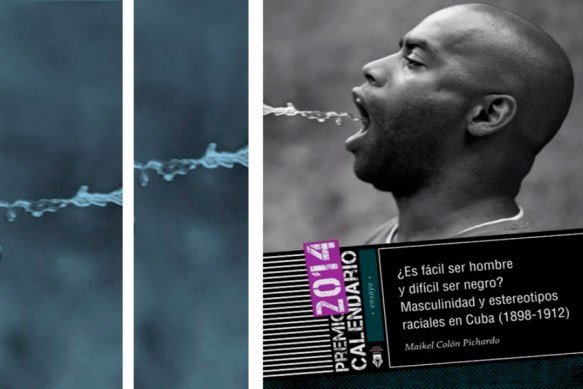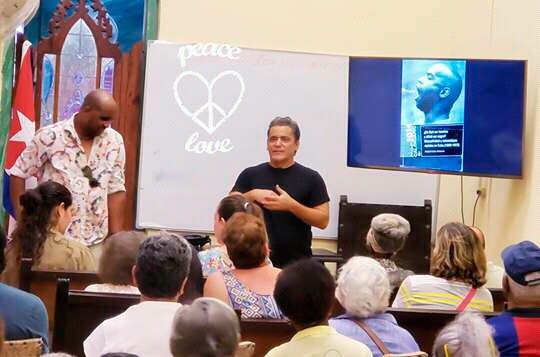Male, Cuban and Black
Adopting a historic view, researcher Maikel Colon Pichardo analyzes masculinities and racial stereotypes in Cuba.

HAVANA TIMES – It might be “the black in bed”, “the black sorcerer” or the age-old wish to “advance” and not “set back your child’s race”. Myths and stereotypes have been passed down from generation to generation ever since the early 19th century and, even though they take the latest guise, discrimination against black and mixed-race people in today’s Cuba continues to be perpetuated.
What are the historic origins of racism and, more specifically, what are black men’s experience of racism on the Caribbean island? This has been the focus of Cuban historian Maikel Colon Pichardo’s research ever since he went to university, when a policeman, with some kind of diligence, asked to see his ID card outside Havana University just because of the color of his skin.
Thinking back, if a policeman saw a young black or mixed-race man with a backpack in the center of the city, he wouldn’t think the latter was on his way to study for some reason, but on the hunt for tourists instead. This association, which is subconscious a lot of the time, is founded on centuries of slavery and a neocolonial republic which was born under US influence, including the promotion of white supremacy.
This singularity of being “male, Cuban and black” has followed him to Europe even, where he worked on his doctoral thesis at the Universidad Autonoma de Barcelona, the Iberoamerican and African Masculinities Network (RIAM) member told us during a presentation at the Cabildo Quisicuaba project’s offices, in the Los Sitios neighborhood in Central Havana.

“It is different there too: being a white Cuban man isn’t the same as being a black Cuban man. And being a black Cuban man isn’t the same as being a black Dominican man, in spite of geographical and cultural proximity,” he explained as he presented his book Es facil ser hombre y dificil ser negro? Masculinidades y estereotipos raciales en Cuba (1898-1912).
However, stereotypes of Black Cuban men have their nuances, both in and outside of Cuba. To the world, there is an extremely sexual projection of the black Cuban male which attracts women and even some groups who come to the country in search of a young black man who “will keep them company” on their Caribbean holiday. Sex and dancing, these might be the two keywords.
In Cuba, their situation becomes and a lot more complex and diverse
“The racialization of sexuality (i.e. that black men have big penises), the association of black men with backward attitudes and the constant construction of myths in regard to criminality and marginality, condition the social representation of black men in different contexts of modern-day Cuba,” Colon Pichardo told IPS Cuba’s editorial team.
In the foreword to the book, Cuban historian and anthropologist Julio Cesar Gonzalez Pages believes that “the perception of men and their masculinity passes through many cultural and dominant orders where race isn’t generally factored in in explicit terms, not even in social research.”
According to the RIAM founder and current Officer of the Swiss Agency for Development and Cooperation’s (COSUDE) programs, the essay that deserved to win the 2016 Calendar Prize from the Hermanos Saiz Assocation, “can already be considered a reference in dealing with racism and its implications in the construction of the machista ideology and the violence and inequality it results in.”
During the debate that arose after the presentation at the Quisicuaba project, Gonzalez Pages and Colon Pichardo agreed that the challenge lies in how to analyze these issues in today’s Cuba in order to make headway with the deconstruction of myths and stereotypes that serve as grounds for different forms of racism.

According to the author of Es facil ser hombre y dificil ser negro?, the first problem that needs tackling lies in the fact that “Cuban society doesn’t see itself as a racist society.”
On this matter, Geidys Fundora, professor at the Latin American Faculty of Social Sciences (FLACSO-Cuba) outlined the obstacles that emerge when trying to work with these issues in projects that are implemented within the community, including a strong resistance to talking about them because it is believed “to go against national unity”.
According to Fundora, arguments to avoid talking about racism include: “white people experience racism too”, “black people themselves are the most racist”, “I’m not a racist because I have lots of black friends”, as well as defending the non-discriminatory character of society by referring to successful black people (such as sports champions), thereby making the rest of the population invisible.
In Colon Pichardo’s opinion, two fronts need to be freed if we want to make headway and deconstruct racism, including its link with black and mixed-race masculinities.
“First of all, there’s the media. Cuban society watches a lot of TV, and Cuban society isn’t represented in all of its diversity on most TV programs (soap operas, music videos, etc.). Black men are almost always represented by the most common racial stereotypes and this can be harmful,” he told IPS Cuba’s editorial team.
He added that this is where “the importance of social communication spaces that have such great influence” come into play, “as racist codes of conduct carry on in Cuban everyday life.”
The second front, in the expert’s view, is State policy: “racism can only be tackled with public policies which have a systematic impact on environments such as education and culture.”
“It isn’t normal that Palon divino by reggaeton artist Chocolate MC (a phallocentric and violent exaltation of masculinity) be accepted so naturally. The reality is a lot more complex than a simple song, but a lot of the time, they are the reflection of constructed and future racial mindsets, if we don’t take immediate action,” he claimed.






Every time this topic comes up here at HT, I have the same comment so apologies to anyone who has read this from me before. Racism in Cuba is alive and well. As a African American I have been stopped countless times in Cuba by Cuban police asking to see my “documentos”. I realize that I look Cuban so I am never surprised by their race-motivated requests. 99% of the time as soon as I show the PNR official my US passport, I am set on my way. I also face the same discrimination in dollar stores and restaurants. And yes, as bad as racism is in Cuba, its much worse in the US.
Being of mixed racial heritage (mostly indigenous and african), but appearing caucasian has given me opportunities.
However, my clearly latino surname and unusual ethnic given name has actually caused me to lose employment and business networking opportunities.
From a certain standpoint I feel both sides of the issue. I have also come to accept that, while I do not consider race in my interactions with others, I can be prejudiced.
Consciousness of our prejudices, and the desire and effort to overcome them is the key to fairness and equality.
Racism if rife all over the globe. What annoys me is when people go to great lengths to insist that they are not a racist. I dislike and like lots of things about people from all across the racial spectrum so if that makes me a racist then yes I am a racist, so learn to live with it at least I am honest!
Very interesting and universal article. You have witnessed racism in Spain and I as a Canadian witness racism in Canada, particularly in large cities like Toronto. In Canada, we euphemistically label racism particularly among police services as “carding”. Exactly as you have pointed out a black man walking down the street minding his own business is pulled over by the police for an “interview”. This has happened on a regular basis to many people of color, black and brown. Some cities are taking a pro-active approach to this discriminatory action and outlawing the practice. There is a different perception of black males in Canada as opposed to your historical Cuban analysis. The racism arises from indoctrination that black males are criminals not necessarily as sex objects; hence, the police must be proactive to prevent crime from occurring and thus “card” black males. Of course, this negative perception in absolutely abhorrent and wrong. In many Canadian cities being male and black is not easy. Let me give you a very Canadian example. Hockey is our national sport. Given their athletic ability, all boys play the game in their local community arenas. Certainly in the past and to some degree today, black youngsters are booed by hockey fans and taunted on the ice by opposing players solely because of the color of their skin. This abhorrent behavior is not what “white” hockey players have to deal with. This is racism at its core. But some black youngsters have persevered and succeeded to overcome such racism and have risen to be all stars in the National Hockey League (NHL): the Subban brothers are prime examples. In turn they donate their time and monetary donations to very worthwhile causes which helps to change the negative black, male perception.
I agree with the experts universal prescription: State policy: “racism can only be tackled with public policies which have a systematic impact on environments such as education and culture.”
It’s all about money and wealth in all counts. Wealth make anybody looks ‘ good.’ The color of the skin don’t matter much if you got the ‘ bucks.’ Lets not forget any other color skin, nationality, religious belief, and political affiliation.